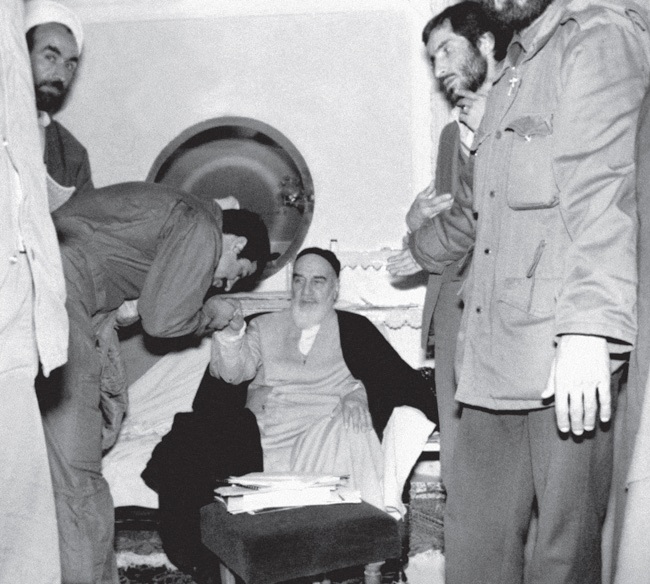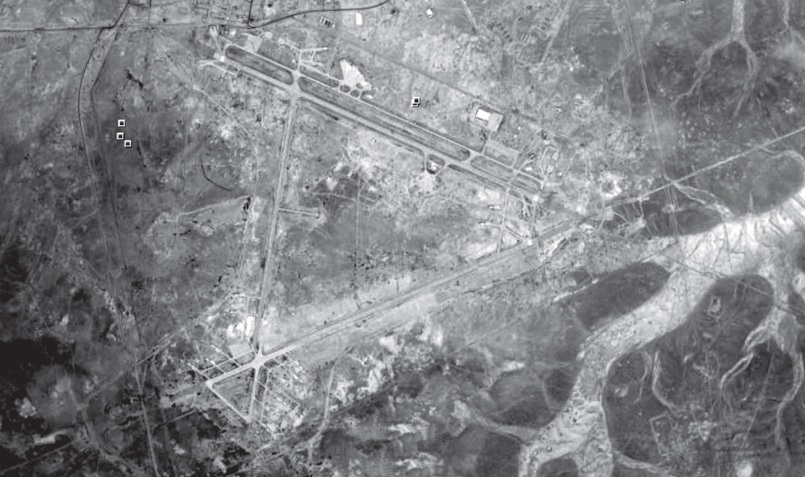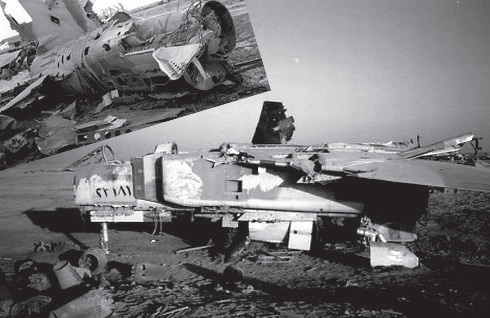Air Raid to Al-Waleed (30)
The Story of Demolishing Fighters and the Equipment in Al-Waleed Triple Military Bases Known as H-3
2016-7-31
Air Raid to Al-Waleed (H-3)
The Story of Demolishing Fighters and the Equipment in Al-Waleed Triple Military Bases Known as H-3
By: Brigadier General Ahmad Mehrnia
Tehran, Sooreh Mehr Publications Company
2010 (Persian Version)
Translated by: Zahra Hosseinian
And read the memory of Ibrahim Pourdan:
"Our team included two aircrafts and should be targeted southern base. An arid desert, sunny weather and low altitude had made us to be much careful, lest we suffered flight confusion (vertigo) and crashed. We left the main team as got closer to the target and headed to the target base. Further away, on that desert and near the base, a blue dome attracted me. I guessed that it should be a mosque when passed it, but I don’t know why it was there. There were many types of aircrafts and helicopters in the Southern Al-Waleed base. Perhaps, about 90 percent of them were helicopters. Number two team was also accompanied us in a tactical distance. Almost all parts of the base were good target. Mr. Kazemi was a skilled teacher and experienced pilot. For this reason, the base damaged considerably. From then on, two things worried me: first, Bagheri and Khazraei’s fate; a serious damage apparently had occurred for their aircraft according to the conversation and gradually they lost aircraft control, and also they weren’t able to refuel. Therefore, a tanker had to guide them to an emergency base to land as soon as possible. Second, the absence of the tanker made refueling of seven aircrafts from one tanker difficult and dangerous. However, a unique operation was done and the enemy was damaged heavily. From then on, I, who was very worried, calmed down strangely and had no concern until we reached to the Hamedan base."
Soleimani, who monitored the situation from rear cockpit, said:
"We were surprised of existing all those aircrafts, helicopters and equipment at the base. Such a hell was raised that Baathists had never dreamed. Their defense forces hadn’t even a tiny chance to shoot a bullet or missile to us."
In this attack, external gasoline tank of Ravadgar’s aircraft damaged. Amir Ravadgar’s memory of Al-Waleed attack is as follow:
"Soleimani’s aircraft and mine carried six fin bombs, so that we can launch them from low altitude. Reaching above the target, I heard unfamiliar sounds when I pressed launching button. I think that the fin of one of bombs opened early and tore the crust of additional tank on the wing. At that time, of course, we didn’t realized what has happened. Otherwise everything went well and we inflicted significant huge damages to the enemy with precise bombardment. Our aircraft had a camera at the rare and I filmed a good and very clear scene of bombing and submitted to the relevant authorities. Iraqi defenses were surprised completely and after hearing the explosion of bombs of first team, they just opened fire. However, this could be dangerous for the last team, but the mission was successfully implemented. Another point should be said is the difficulty of refueling at an altitude of a thousand of feet. Being attached to the tanker along with intense shakings was difficult, and I prayed that no problem came up which made fueling boom to be detached, or God knew what occurred."
About occurrence of this problem, Soleimani says:
"We again closed to the refueling tanker. In the rout from target to refueling tanker, our gasoline reduced more. Finally, it was our turn to refuel. Although we gave gasoline, the tanks weren’t filled. With signaling of a member of our team, we realized that the crust of one of external fuel tanks has been torn and gasoline went out. Therefore, we had to exclude and leave it from the refueling operation. We were able to fill internal fuel tank in this way and turned back to the country with lighter weight and lower drag (air resistance). It was interesting that when we entered the insider board, Ravadgar decided not to refuel for the last stage, by looking at the gasoline situation, so we went directly to the Hamedan base and landed with very little gasoline. But all of these dangers and frustrations were replaced with an incredible calm and comfort, when we were received in audience of the Leader of Revolution and kissed his hand."

First Lt. Ahmad Soleimani in a meeting with Imam Khomeini, Hojjat-ol-Islam Mohammadi Golpayegani can be seen on the left.
When I asked Ravadgar why you run such a risk and without refueling in the final stage you headed to the Hamedan base, he replied with a smile:
"To Engage in reckless activities! I thought that we should keep flying to find tankers. Then refuel for few minutes. In addition, my calculations assured me that we reach to the base. We landed, however, with a very little gasoline, about 600 to 700 pounds, which means lack of fuel for F-4 aircraft."
The main leader of flight, Major Baratpour, who led the last three aircraft team to be a load off his mind about the rest of participants and he himself took the greatest risk, says:
"For surprising the enemy and because we could leave the location with minimum circulation that may be dangerous for team after destruction the targets, I decided to attack the target from Western south. For this reason, I led the team to the final circulation spot, which was lower than the targets, and from there each group were separated and continued towards their target.

Aerial photograph of Main Al-Waleed Air Base or Eastern H-3
In a three aircrafts group, we were turning toward the target when I saw a pillar of fire and smoke and dust in the region. I realized that my colleagues have done their job well. But the enemy anti-aircraft which had been completely surprised and didn’t expect us, had been activated when other members of group reached to their targets and frantically fired at us on every side without seeing us. For this reason, we changed the rout to the inside of Iraq by immediate decision and after flying about 15 to 20 nm more than determined distance in the plan, we attacked from East to the West, to the main base which was our target. At this moment, the anti-aircraft of region had been relatively stopped, because some time had passed and nothing had happened, so it created a good space for us to surprise them once again. It was a huge base and many aircrafts and equipment had been scattered there. I regretted that we couldn’t have another four aircrafts with us, because they could inflict fatal damages upon the enemy. Fortunately, we bombed target accurately and effectively without any problem, and destroyed many of the best aircrafts of Iraq; and then kept flying toward tankers, following two groups which attacked targets before us. Interestingly enough, I saw a military truck carrying supplies and moved from Jordan border toward the same base, immediately after bombing the target. Quickly I flew in its direction and destroyed it with a machine gun. Due to the good weather, the filming of this incident was also very good. I think this film is still available in the archives of the Air Force.

The tail and body of one of destroyed Iraqi MiG-23 fighter/bombers which were used extensively in the war.
However our attack was very successful, but Khazraei’s conversation which indicated difficult emergency situation, worried me. I knew that Kazemi, one of our brave and experienced pilots, is with him and certainly tries to lead the aircraft toward the tanker trouble-free. However, I couldn’t take it anymore and flew toward damaged aircraft on that critical condition as a leader and responsible for the entire flight team, and accompanied it to the nearest tanker. The hydraulic system of the aircraft was damaged and it was not able to refuel. Therefore, according to coordination with Izadseta, we decided that the tanker which carried him accompanied this aircraft to the considered airport. From now on, we again kept flying toward north side in the form of two flight team along with a tanker, and filled our tanks once again in the way. Near the intersection of the borders of Iraq, Turkey and Syria, we continued flying toward our Islamic Home, to the home of warriors and heroes who taught a harsh lesson to the invaders with their self-sacrificing. Returning to our home, I saw a number of Iraqi fighters looking for us. I am sure they saw us, but because of our high speed and the circulation they must to do to reach out to us, we distanced much and they never could meet their wish that was our overthrow. I should say that our success in this high-risk operation was not possible except by the will of God and God help us to feel proud.__
To be continued…
Number of Visits: 5705








The latest
- 100 Questions/ 2
- Mohammad — The Messiah of Kurdistan
- The 371st Night of Memory – 3
- Third Regiment: Memoirs of an Iraqi Prisoner of War Doctor – 2
- 100 Questions/ 1
- Oral Narratives: An Open Window into Cultural Discourse
- Prerequisites and Methodology for Compiling Oral History
- Third Regiment: Memoirs of an Iraqi Prisoner of War Doctor – 1
Most visited
- Third Regiment: Memoirs of an Iraqi Prisoner of War Doctor – 1
- Prerequisites and Methodology for Compiling Oral History
- Oral Narratives: An Open Window into Cultural Discourse
- Third Regiment: Memoirs of an Iraqi Prisoner of War Doctor – 2
- 100 Questions/ 1
- The 371st Night of Memory – 3
- 100 Questions/ 2
- Mohammad — The Messiah of Kurdistan
From Javanrud to Piranshahr
The Memoir of Reza MohammadiniaThe book From Javanrud to Piranshahr recounts the life and struggles of Commander Reza Mohammadinia, who spent part of the Iran–Iraq War in the western and northwestern regions of the country. During those years, he held responsibilities such as deputy commander of the Seventh Region of the Islamic Revolutionary Guard Corps (IRGC), acting head of the Javanrud district, service on the southern fronts, director of ...
Tactical and Strategic Analysis and Limitations
The present paper, entitled “A Critical and Scholarly Study of Dr. Hossein Alaei’s Two-Volume Book: Tactical and Strategic Analysis and Limitations”, is a research work that examines and evaluates the two-volume book “An Analytical History of the Iran-Iraq War”. In this study, the strengths and weaknesses of the work are analyzed from the perspectives of content critique, methodology, and sources.Clarifying the Current Situation; Perspectives of the Oral History Website
The definition of a “journalist” and the profession of “journalism” is not limited to simply “gathering,” “editing,” and “publishing breaking news.” Such an approach aligns more with the work done in news agencies and news websites. But now, after years of working in the field of books for various news agencies, newspapers, and magazines, when I look back, I realize that producing and compiling content for ...

